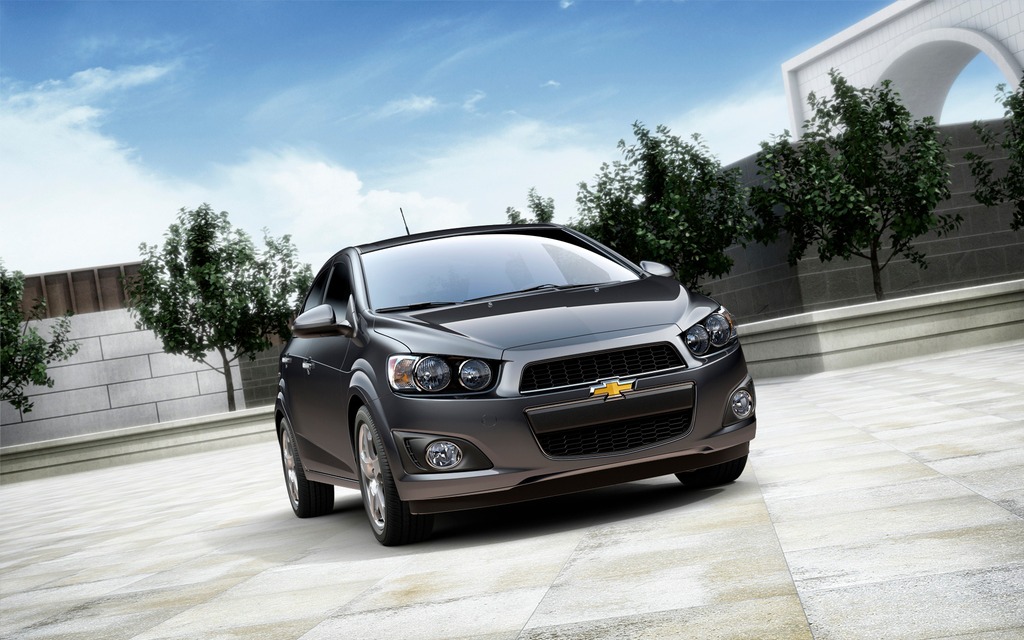2014 Chevrolet Sonic : Chevy’s Warmed-up Hatch

| Strong points |
|
|---|---|
| Weak points |
|
Chevrolet took a considerable step forward in performance and driving pleasure when it replaced the not-so-exciting Aveo with the Sonic in 2012. While the Aveo represented basic transportation for drivers on a budget, the Sonic adds a little bit of gusto and pizzazz to the formula.
Subcompact hatchbacks have never been GM’s forte, the company usually presenting more conservative offerings in the field. The Sonic, however, especially when equipped with the 1.4-litre Ecotec turbocharged four, is the company’s most engaging hatchback yet. With sportier, more aggressive styling and a much-needed interior makeover, the Sonic is a much worthier competitor in a segment populated by cars like the Ford Fiesta, Honda Fit, Hyundai Accent, Kia Rio, Mazda2 and Toyota Yaris.
Power for the people
Chevrolet offers two engines in the Sonic; a 1.8-litre Ecotec naturally aspirated four, available in LS and LT models, and the 1.4-litre turbocharged four mentioned above, available in LTZ and RS models. Both engines, which are shared with the Chevy Cruze, produce 138 horsepower, but the turbocharged version has the upper hand in torque, producing a peak of 200 Nm (148 lb.-ft.), an increase of 30 Nm (23 lb.-ft.) over the non-turbocharged engine. Only the Kia Rio matches the Sonic’s 138 hp, but the latter produces 33 Nm more peak torque thanks to its turbocharger.
The LTZ’s turbocharged engine is smooth and quiet at cruising speeds, and when asked to perform it propels the 1,259 kg Sonic competently, especially when considering the engine’s small displacement. There’s a noticeable lag when stepping on the gas pedal, a by-product of the pressurised intake charge, but once it gets spinning it pulls with much more authority than its non-turbocharged foes from Japan and Korea. The engine does get noticeably louder if revved above 4,000 rpm, though the increased sound isn’t intrusive.
Although claimed combined fuel consumption for the turbocharged Sonic equipped with an automatic transmission is 6.7L/100 km, driving normally we measured an average of 8.7L/100 km in a 60/40 combination of city and highway driving, confirmed by the onboard trip computer, which registered a slightly more optimistic 8.4L/100 km.
The optional six-speed automatic is smooth and efficient but ultimately it saps the driving fun, and there’s not much more enjoyment to be had shifting the transmission manually, which is done via a rocker switch on the gearshift knob. If you want a more engaging driving experience, stick with the standard-equipment, six-speed manual. LS and LT models come with a standard five-speed manual.
Upping the ante
Handling dynamics are respectable, the Sonic exhibiting minimal body roll through turns and well-balanced electric power steering. Torque steer, however, makes a presence, tugging at the steering wheel when you mash down on the gas pedal. The torsion-beam rear suspension, which is the segment standard, allows the rear end to bob and squat somewhat when accelerating and braking, but overall the suspension is compliant and quiet in operation.
The interior, which was a considerable improvement over the Aveo, still makes abundant use of hard plastic, though interior stylists have made an effort to give it a quality feel by applying various textures and colour shades, and by incorporating a wrap-around centre console that gives the Sonic a more inviting cockpit. An interesting touch that might not be to everyone’s liking is the modular gauge cluster that looks like it was lifted directly from a motorcycle and bolted to the Sonic’s dash. It has a prominent tachometer flanked on the right by digital readout that shows speed, trip computer info, compass heading and trip odometer.
Interior space for all occupants is commendable. There’s just a little bit less headroom but more legroom front and rear than the class-leading Honda Fit, and cargo capacity, at 538 litres with the rear seatbacks up and 1,351 litres with the seatbacks folded down, is on par with the Accent, though the Fit is still the cargo king with a total capacity of 1,622 litres. The only caveat is that the sloping roofline limits rear visibility.
Standard interior amenities are abundant, including heated front seats, a 60/40-split folding rear seat, power windows and locks, a six-speaker sound system with CD player and SiriusXM satellite radio (with a free three-month subscription), and steering wheel controls for the radio, phone and cruise control. Front seats are manually adjustable as is the telescopic and tilt steering wheel.
Chevy offers MyLink for an additional $265, which is a reasonable price to pay for the convenience of a centrally mounted, 7-inch touch-screen sound system, that in addition to satellite radio includes Bluetooth connectivity, USB and auxiliary ports, and is Stitcher compatible for streaming videos and music through your smart phone.
Hatchbacks are popular among a broad range of drivers; they are sporty, practical, fuel efficient and stylish. In LTZ trim the Sonic is priced a little higher than its competitors, but it’s the only car among its peers to offer a turbocharger, and it’s loaded with standard features that are extra-cost options on many of the other cars. With the Sonic, Chevy has done a fine job in producing a competent, attractive hatch with class-leading power.











